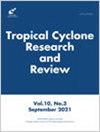El Niño-Southern涛动(ENSO)对印度尼西亚海域热带气旋特征的影响
IF 4.1
4区 地球科学
Q3 METEOROLOGY & ATMOSPHERIC SCIENCES
引用次数: 0
摘要
印度尼西亚与印度洋和太平洋接壤,受热带气旋活动以及厄尔Niño-Southern涛动(ENSO)和印度洋偶极子(IOD)等现象的影响。本研究考察了印度尼西亚四个地区的TC变化,重点关注IOD为中性时的ENSO事件。在过去50年中(1973-2022),有2885个热带气旋(tc)经过印度尼西亚海域,其中最活跃的区域是2区。在El Niño期间,印度尼西亚各地的TC发生率增加,而La Niña总体上的TC发生率减少,但存在区域差异。在La Niña期间,由于垂直风切变(VWS)和涡度等不利的环境因素,区域2的TCs每月减少12.5%。相反,区域3和区域4则分别增加了38.1%和45.7%,这主要归因于海面温度和湿度等有利条件。累积气旋能量(ACE)分析显示,在El Niño期间,1区增加65.4%,2区增加12.4%,而2区在La Niña期间减少35.3%。核密度估计(KDE)突出了季节性和enso驱动的空间变化,在La Niña期间,密度中心普遍向东移动,除了区域2向西移动。最大的移动,632.1公里,发生在La Niña期间的第4区,将TC地层从西努沙登加拉附近移动到帝汶海。对不同地区各热带气旋事件ENSO期间显著波高(SWH)的分析表明,El Niño和La Niña期间密度中心的变化也会影响印度尼西亚海域的显著波高变化。这些发现强调了ENSO对印度尼西亚水域TC活动的影响,为改进防备和海洋安全提供了有价值的见解。本文章由计算机程序翻译,如有差异,请以英文原文为准。
The influence of El Niño-Southern Oscillation (ENSO) on the characteristics of tropical cyclones in Indonesia waters
Indonesia, bordered by the Indian and Pacific Oceans, is influenced by tropical cyclone (TC) activity and phenomena such as the El Niño-Southern Oscillation (ENSO) and Indian Ocean Dipole (IOD). This study examines TC variations across four Indonesian regions, focusing on ENSO events when the IOD is neutral. Over the past 50 years (1973–2022), 2,885 tropical cyclones (TCs) have passed through Indonesian waters, with the most active area being Region 2. During El Niño, TC occurrences across Indonesia increase, while La Niña sees fewer TCs overall but with regional variations. Region 2 experiences a 12.5 % monthly decrease in TCs during La Niña due to less favourable environmental factors like vertical wind shear (VWS) and vorticity. Conversely, Regions 3 and 4 show increases of 38.1 % and 45.7 %, respectively, attributed to supportive conditions such as sea surface temperature and humidity. Accumulated Cyclone Energy (ACE) analysis reveals significant changes, with increases of 65.4 % in region 1 and 12.4 % in region 2 during El Niño, while region 2 decreases by 35.3 % during La Niña. Kernel Density Estimation (KDE) highlights seasonal and ENSO-driven spatial shifts, with density centres generally moving eastward during La Niña, except for region 2, which shifts westward. The largest shift, 632.1 km, occurred in region 4 during La Niña, moving TC formations from near West Nusa Tenggara to the Timor Sea. Analysis of Significant Wave Height (SWH) during ENSO periods for each tropical cyclone event in different regions shows that shifts in density centers during El Niño and La Niña also influence SWH variability in Indonesian waters. These findings underscore the impact of ENSO on TC activity in Indonesian waters, providing valuable insights for improving preparedness and marine safety.
求助全文
通过发布文献求助,成功后即可免费获取论文全文。
去求助
来源期刊

Tropical Cyclone Research and Review
METEOROLOGY & ATMOSPHERIC SCIENCES-
CiteScore
4.60
自引率
3.40%
发文量
184
审稿时长
30 weeks
期刊介绍:
Tropical Cyclone Research and Review is an international journal focusing on tropical cyclone monitoring, forecasting, and research as well as associated hydrological effects and disaster risk reduction. This journal is edited and published by the ESCAP/WMO Typhoon Committee (TC) and the Shanghai Typhoon Institute of the China Meteorology Administration (STI/CMA). Contributions from all tropical cyclone basins are welcome.
Scope of the journal includes:
• Reviews of tropical cyclones exhibiting unusual characteristics or behavior or resulting in disastrous impacts on Typhoon Committee Members and other regional WMO bodies
• Advances in applied and basic tropical cyclone research or technology to improve tropical cyclone forecasts and warnings
• Basic theoretical studies of tropical cyclones
• Event reports, compelling images, and topic review reports of tropical cyclones
• Impacts, risk assessments, and risk management techniques related to tropical cyclones
 求助内容:
求助内容: 应助结果提醒方式:
应助结果提醒方式:


